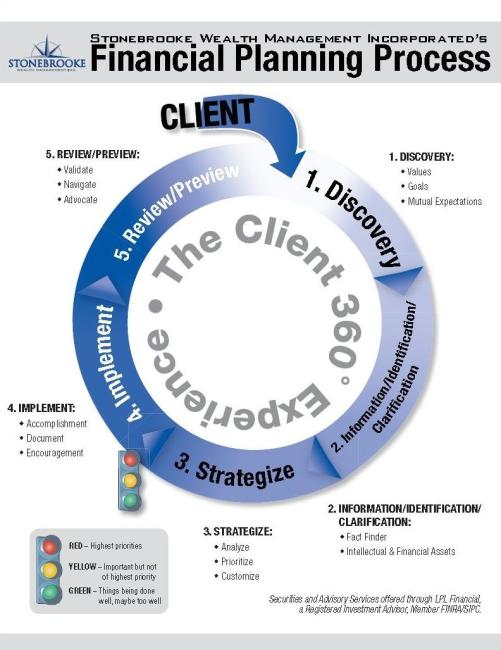Our first priority is helping you take care of yourself and your family. We want to learn more about your personal situation, identify your dreams and goals, and understand your tolerance for risk. Long-term relationships that encourage open and honest communication have been the cornerstone of my foundation of success. Watch our President and LPL Registered Principal, Bob Bayer explaining our five-step-by-step process.
Financial Planning Process
Our financial planning process:
A key component of financial planning is having a clear and dynamic process that’s easy to understand. Our process has five continuous steps:
1. Discovery:
It is critical to understand your values, goals, risk tolerance and time horizons. During the Discovery phase, we’ll invest time in your current situation, discovering and prioritizing what’s most important to you, set the mutual expectations of each other, and determine the investment amount required for a planning relationship. This step is one typically filled with multiple questions as we set the table for plan construction.
2. Information/Identification/Clarification:
Here, a list of information needed by us will be provided to you for completion. It is critical all information be disclosed for an accurate plan to be developed for implementation. Included here is uncovering a list of your non-financial investments. Examples are faith, health, education, wisdom, and life experiences to name a few. By doing this, we attach meaning to the reason “why” your financial assets are important for you. It is not uncommon to have several goals, some short term and some long term.
3. Analyze/Strategize/Customize:
The financial plan can provide details how to pursue your goals. In this phase we’ll have identified things you’ve been doing well maybe even too well, things that are a concern but maybe not of the highest priority and things that may need immediate attention. Examples can include increasing your cash flow by reducing unnecessary expenses, proper protection planning, or investing in the stock market after a proper risk assessment.
4. Implementation:
Execution of one’s personal financial plan requires discipline and perseverance. Many people obtain additional assistance from professionals such as accountants, and lawyers. Surrounding yourself with appropriate financial, legal and tax advice is recommended. A financial plan with no action will provide no benefit to you and your loved ones. Take the necessary steps to begin moving forward.
5. Review and Preview:
As time passes, circumstances will change. One’s personal financial plan must be monitored for possible adjustments. The review of what’s been working since your plan inception is equally as important as planning ahead for your future. Examples here may include creating streams of life long income, tax loss harvesting, re-balancing a portfolio, as well as focusing on the road ahead.


